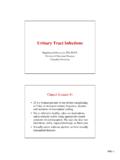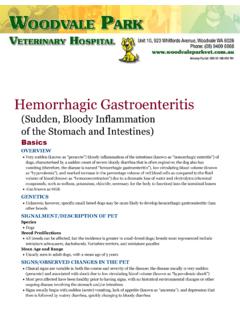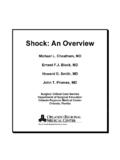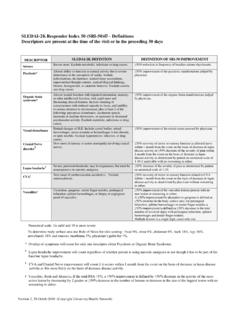Transcription of Crimean-Congo Hemorrhagic Fever
1 Crimean-Congo Hemorrhagic Fever Introduction Crimean-Congo haemorrhagic Fever (CCHF) is a viral haemorrhagic Fever caused by Nairovirus. Although it is primarily an animal disease, sporadic cases and outbreaks of CCHF affecting humans do occur. CCHF outbreaks constitute a threat to public health because of its epidemic potential, high case fatality, potential for nosocomial outbreaks, and difficulties in treatment and prevention. CCHF virus is enzootic in the southern part of Europe (Balkans), Turkey, the southern Russian Federation, and in several countries in the Middle East, of sub-Saharan Africa, central Asia and the western part of China. The disease was first described in the Crimea in 1944-45 when more than 200 cases of an acute, Hemorrhagic , febrile illness occurred soldiers and given the name Crimean haemorrhagic Fever . In 1969 it was recognized that the pathogen causing Crimean haemorrhagic Fever was the same as that responsible for an illness identified in 1956 in the Congo, and linkage of the two place names resulted in the current name for the disease and the virus.
2 Geographical distribution The geographical distribution of the virus, like that of its tick vector, is widespread. The disease is endemic in many countries in Africa, Europe and Asia, and outbreaks have been recorded in Kosovo, Albania, Islamic Republic of Iran, Pakistan, and South Africa among other countries. Turkey has been known to be endemic for human CCHF and between 2002 and 2008, 2508 cases of CCHF with 133 deaths (case-fatality ) rate have been reported by the Ministry of Health of Turkey. Between 1 January and 30 June 2008 itself, a total of 688 confirmed cases (with 41 deaths, CFR: ) have been reported in Turkey. In May 2010 hospitals in Kosovo 's Kosovo Polje reported 70 cases of CCHF, with 4 deaths. In September, 2010 an outbreak was reported in Pakistan 's Khyber Pakhtunkhwa province. The extent of the outbreak is uncertain, though some reports indicate over 100 cases, with a case-fatality rate above 10%. In SEAR, the first laboratory confirmed case was reported on 19 January, 2011 in Gujurat state of India bordering with Pakistan.
3 Causal agent The virus which causes CCHF is a Nairovirus, a group of related viruses forming one of the five genera in the Bunyaviridae family of viruses. All of the 32 members of the Nairovirus genus are transmitted by ixodid ticks in animals, but only three have been implicated as causes of human disease and CCHF virus is the most important human pathogen amongst them. CCHF virus is highly dangerous pathogen and it is investigated in high biosafety laboratories. Reservoirs and vectors The CCHF virus may infect a wide range of domestic and wild animals. Animals become infected with CCHF from the bite of infected ticks. A number of tick genera are capable of becoming infected with CCHF virus, but the most efficient and common vectors for CCHF appear to be members of the Hyalomma genus. Transovarial transmission (transmission of the virus from infected female ticks to offspring via eggs) and venereal transmission have been demonstrated amongst some vector species, indicating one mechanism which may contribute to maintaining the circulation of the virus in nature.
4 However, the most important source for acquisition of the virus by ticks is believed to be infected small vertebrates on which immature Hyalomma ticks feed. Once infected, the tick remains infected through its developmental stages, and the mature tick may transmit the infection to large vertebrates, such as livestock. Domestic ruminant animals, such as cattle, sheep and goats, are viraemic (virus circulating in the bloodstream) for around one week after becoming infected. Mode of transmission Humans who become infected with CCHF acquire the virus from direct contact with blood or other infected tissues from livestock having viraemia, or they may become infected from a tick bite. The majority of cases have occurred in those involved with the livestock industry, such as agricultural workers, slaughterhouse workers and veterinarians. CCHF can be transmitted from one infected human to another by contact with infectious blood or body fluids.
5 Documented spread of CCHF has also occurred in hospitals due to improper sterilization of medical equipment, reuse of injection needles, and contamination of medical supplies. Nosocomial infections were documented in Albania, Bulgaria, Turkey, Russia, Iran and Pakistan. At-risk populations Animal herders, livestock workers, and slaughter houses in endemic areas are at risk of CCHF. Healthcare workers in endemic areas are at risk of infection through unprotected contact with infectious blood and body fluids. Individuals and international travelers with contact to livestock in endemic regions may also be exposed. Clinical features among humans The length of the incubation period for the illness appears to depend on the mode of acquisition of the virus. Following infection via tick bite, the incubation period is usually one to three days, with a maximum of nine days. The incubation period following contact with infected blood or tissues is usually five to six days, with a documented maximum of 13 days.
6 Onset of symptoms is sudden, with Fever , myalgia, dizziness, neck pain and stiffness, backache, headache, sore eyes and photophobia. There may be nausea, vomiting and sore throat early on, which may be accompanied by diarrhoea and generalized abdominal pain. Over the next few days, the patient may experience sharp mood swings, and may become confused and aggressive. After two to four days, the agitation may be replaced by sleepiness, depression and lassitude, and the abdominal pain may localize to the right upper quadrant, with detectable hepatomegaly. Other clinical signs which emerge include tachycardia, lymphadenopathy, and a petechial rash, both on internal mucosal surfaces, such as in the mouth and throat, and on the skin. The petechiae may give way to ecchymoses and other haemorrhagic phenomena such as melaena, haematuria, epistaxis and bleeding from the gums. There is usually evidence of hepatitis. The severely ill may develop hepatorenal and pulmonary failure after the fifth day of illness.
7 The mortality rate from CCHF is approximately 30% among hospitalized patients (range 5-50%), with death occurring in the second week of illness. In those patients who recover, improvement generally begins on the ninth or tenth day after the onset of illness. Long-term effects of those surviving have not been documented well. Diagnosis There are no rapid diagnostic tests. Diagnosis of suspected CCHF is performed in specially-equipped, high bio-safety level laboratories. IgG and IgM antibodies may be detected in serum by enzyme-linked immunoassay (the "ELISA" or "EIA" methods) from about day six of illness. IgM remains detectable for up to four months, and IgG levels decline but remain detectable for up to five years. Patients with fatal disease do not usually develop a measurable antibody response and in these individuals, as well as in patients in the first few days of illness, diagnosis is achieved by virus detection in blood or tissue samples.
8 The virus may be isolated from blood or tissue specimens in the first five days of illness, and grown in cell culture. Viral antigens may sometimes be shown in tissue samples using immunofluorescence or EIA. The polymerase chain reaction (PCR) and Real-Time PCR, a molecular method for detecting the viral genome, has been successfully applied in diagnosis. Laboratory diagnosis of a patient with a clinical history compatible with CCHF can be made during the acute phase of the disease by using the combination of detection of the viral antigen (ELISA antigen capture), viral RNA sequence (RT-PCR) in the blood or in tissues collected from a fatal case and virus isolation. Immuno-histochemical staining can also show evidence of viral antigen in formalin-fixed tissues. Later in the course of the disease, in people surviving, antibodies can be found in the blood. Treatment CCHF is a severe disease in humans, with a high mortality rate. Fortunately, human illness occurs infrequently.
9 General supportive therapy is the mainstay of patient management in CCHF. Intensive monitoring to guide volume and blood component replacement is required. The antiviral drug ribavirin has been used in treatment of established CCHF infection with apparent benefit. Both oral and intravenous formulations seem to be effective. Appropriate treatment of secondary infections should be instituted. Prevention and control Although an inactivated, mouse brain-derived vaccine against CCHF has been developed and used on a small scale in Eastern Europe, there is no safe and effective vaccine widely available for human use. The tick vectors are numerous and widespread and tick control with acaricides (chemicals intended to kill ticks) is only a realistic option. Persons living in endemic areas should use personal protective measures that include avoidance of areas where tick vectors are abundant and when they are active; regular examination of clothing and skin for ticks, and their removal; and use of repellents is recommended.
10 Patients with suspected or confirmed CCHF should be isolated and cared for using barrier nursing techniques. Specimens of blood or tissues taken for diagnostic purposes should be collected and handled using universal precautions. Sharps (needles and other penetrating surgical instruments) and body wastes should be safely disposed of using appropriate decontamination procedures. Healthcare workers are at risk of acquiring infection from sharps injuries during surgical procedures and, in the past, infection has been transmitted to surgeons operating on patients to determine the cause of the abdominal symptoms in the early stages of infection. Healthcare workers in endemic areas should be aware of the illness. When patients with CCHF are admitted to hospital, there is a risk of nosocomial spread of infection. In the past, serious outbreaks have occurred in this way and it is imperative that adequate infection control measures be observed to prevent the infection.















